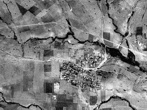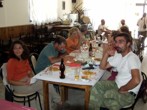|
|
| Village |
| The archaeological site of Paliambela is situated next to the small village of 266 inhabitants of the same name. The recent reformulation of the local authorities on the basis of the "Kapodistria" plan placed Paliambela and three more neighbouring villages within the Municipality of Kolindros. |
| |
| Form |
Paliambela is a peaceful village. Pretty like all villages situated on a plain, it is almost exclusively made up of small single-storey houses of charming simplicity. The main features of the settlement are the church and the old school. The extensive school-yard includes a basketball court and a children's playground, and forms what is essentially a central square in the village.
It is also the site of the memorial for those who fell during the Second World War. Another children's playground is to be found at the opposite end of the village, where there used to be an older square. The village has a couple of food stores and two coffee shops that are open all year round. Public services, supermarkets and entertainment venues are available in the neighbouring towns of Eginio and Kolindros. |
| |
| History |
| There was a small settlement in the area from Byzantine times which continued into the Ottoman period. Very little is known about this period, with the exception of some accounts taken from the residents. A planned study of the Ottoman archives for the area will perhaps shed some light on these periods. Essentially, the village took its current form with the arrival of the refugees in 1923 and the ensuing redistribution of land made by the Ministry of Agriculture in ??? which is still in force today. According to the plan, each household was given around 1,000 square metres for the construction of a house with a garden. The included agricultural land was divided up in accordance with the small holdings of the inhabitants. |

|
| |
| Current Situation |
| As is clear from the aerial photos, the site has changed little until today. Essentially, the only addition is the neighbouring fruit-canning factory of the Kolindros Agricultural Co-op (which now belongs to the "I PROODOS" Makrychori Co-op), the running of which tends to have significant environmental repercussions for the area. Despite this, changes are almost imperceptible in small settlements like Paliambela. The uninterrupted continuation of the farming character of the area has contributed to the continuation of the residential motif. The main characteristic of the village remains the human scale which works in harmony with the surrounding landscape. |
| |
| The Excavation |
 The inhabitants of Paliambela immediately embraced the archaeological project and aided the essential infrastructure of the work in every possible way. And so the old state school, which had closed its doors due to a lack of students, was given over to the excavation to be made into a place of study and storage for the finds. Some old agricultural storerooms have also been granted to the excavation to store the material and the tools. Finally, the houses that are provided to accommodate the numerous members of the archaeological team are also a significant help. The inhabitants of Paliambela immediately embraced the archaeological project and aided the essential infrastructure of the work in every possible way. And so the old state school, which had closed its doors due to a lack of students, was given over to the excavation to be made into a place of study and storage for the finds. Some old agricultural storerooms have also been granted to the excavation to store the material and the tools. Finally, the houses that are provided to accommodate the numerous members of the archaeological team are also a significant help. |
|
|





